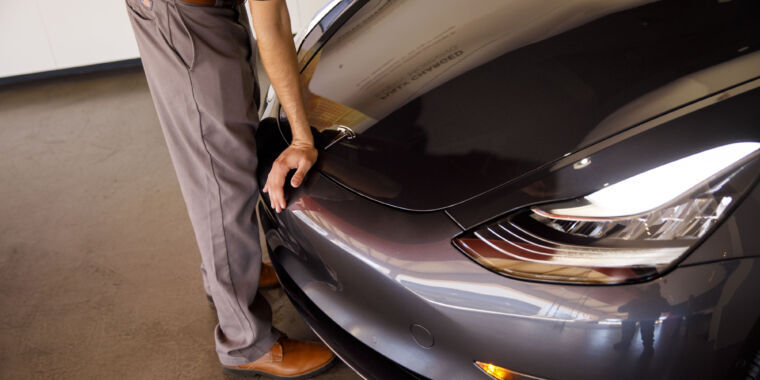The electric car manufacturer Tesla had to issue a massive recall this month to fix faulty hood latches that can open while its cars are driving. The problem affects more than 1.8 million cars, which means it’s slightly smaller than the recall in December that applied to more than 2 million Teslas.
The problem, according to the official National Highway Traffic Safety Administration’s Part 573 safety recall report, affects model year 2021–2024 Model 3s (built between September 21, 2020, and June 2, 2024), model year 2021–2024 Model Ss (built between January 26, 2021, and July 15, 2024), model year 2021–2024 Model Xs (built between August 18, 2021, and July 15, 2024), and model year 2020–2024 Model Ys (built between January 9, 2020, and July 15, 2024).
The problem first became apparent to Tesla in March of this year after complaints about unintended hood opening from Chinese customers. By April, it had identified the problem as deformation of the hood latch switch, “which could prevent the customer from being notified about an open hood state.”
Although the problem is with the hood latch, as with many Tesla safety recalls, the problem can be fixed with an over-the-air software patch. The new software is able to detect if the hood is open and, if so, will display a warning to the driver to alert them to stop their vehicle and secure the hood.



Driving on the highway
Hood pops open. Can’t see anything. Try to brake but crash.
⚠️ Warning! Your hood is open. Please pull over in a safe location and secure your hood.
Tesla: OTA update successful
Yup. No reason to rewrite the playbook.
“Full self driving” detects an imminent collision of it’s own doing. Car beeps and shuts off “full self driving”
Human was “in control” at the time of the crash, not our fault.
Human was supposed to be in control the whole time. In a Tesla and in basically any car, very limited exceptions apply. If some asshole goes to sleep at the wheel that’s the asshole’s fault.
Yeah but turning off assists the split second before a crash is a bullshit way to try and claim it wasn’t involved in the crash. Tesla was caught doing that a couple years back.
Yeah, that’s just fucking lying to the public.
This is an unrealistic standard. We are not robots. We didn’t come with a standby mode unless we’ve actually worked on silently watching a vista while being ready to act at a moment’s notice. And honestly, even the people we pay to do that have problems with inattentiveness and falling asleep.
We need to jump from actually controlling the vehicle to a self driving system good enough to take a nap in. The middle part is extremely dangerous to humans.
True. That’s why driving with assist sytems does not make driving more safe.
Get a Mercedes. They guarantee you some (limited, but still) hands-free time in the driver seat.
I disagree, even the middle part is safer than before. It’s a net positive and will continue to improve.
It’s safer as a backup system yes. As a nudge in the wheel near the lines, as a light brake before the AEB has to kick in. Tesla’s is not safe. It makes people look elsewhere for engagement when the car is not ready to take full control.
Just like the rumored cut all driver aids instant before crash to say it wasn’t due to any of the auto pilot features
The only way the hood can pop open on the highway is if it was open before you departed, so the warning would alert the user just like the switch did before they can drive to a dangerous speed.